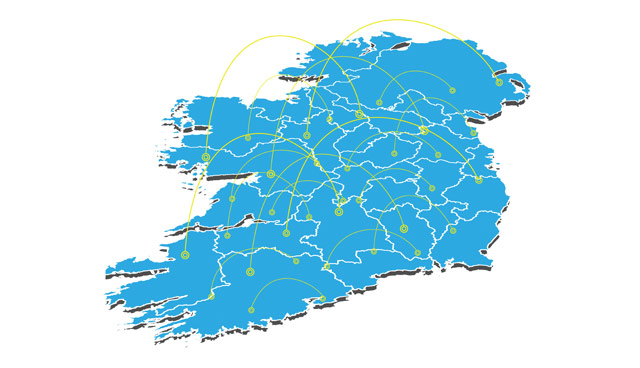A tale of two economies

Economic journalist Paul Gosling assesses the emerging contrasts between the two economies on the island of Ireland and analyses the three major economic arguments being put forward against Irish reunification.
The Republic of Ireland’s economy will grow by 4.9 per cent this year, while Northern Ireland’s will grow by 1.1 per cent, according to predictions from accountancy and consultancy firm EY in its most recent Economic Eye review. This is not a one-off. Last year, the Republic of Ireland’s economy grew by 7.8 per cent, compared to 1.6 per cent in Northern Ireland. And, expects EY, the South’s economy will grow by between 1.6 per cent and 3.8 per cent more than the North’s economy in each of the next five years.
Economic output isn’t everything – and given the Republic of Ireland’s dependence on foreign direct investment, the output statistics are unreliable. So, the jobs situation is more significant. At present the employment rate – the percentage of adults of working age who are working – is slightly higher in Northern Ireland than in the Republic of Ireland. But the figures are likely to diverge widely in the coming years. EY expects the Republic of Ireland to create 227,200 jobs in the period 2017 to 2022, while Northern Ireland generates just 9,500 jobs.
More growth is needed in Northern Ireland to create additional jobs. And the differential in the jobs rate across Northern Ireland that should also have been of much greater concern to policy-makers over the generations. In the Derry and Strabane council area, the employment rate is a mere 56.8 per cent, compared to 69.3 per cent in Northern Ireland as a whole and 75.6 per cent across the UK. This suggests a massive failure in sub-regional economy policy. The same criticism could be made of economic policy in England – and is surely a factor in the Brexit referendum, in which much of de-industrialised northern England voted leave.
The factors behind the weakness of the economy in the North West are the same for the rest of Northern Ireland, just to a different extent. Government here – both devolved and direct rule – failed to invest in the future. The Republic of Ireland put funding into skills and infrastructure, while Northern Ireland underinvested in both. Meanwhile, the Republic of Ireland’s low corporate tax rate attracted massive foreign direct investment. One result of these three types of investment is that the Republic of Ireland has a productivity level 60 per cent higher than that of Northern Ireland, calculates PwC. And productivity is a major factor in growth, wealth and inward investment.
All this is before Brexit. Brexit will clearly damage the Republic of Ireland in terms of reducing its growth. But the UK will be more damaged. Within the UK, Northern Ireland is poised to be the worst hit area of all. Northern Ireland faces the perfect economic storm. Agri-food is very important for Northern Ireland and vulnerable to Brexit. Border areas are another serious concern. And the lesson from the last recession is that the weakest economies suffer the most when things go bad. The scale of the predicted damage varies according to the type of Brexit, with the worst impact felt if we crash out without a deal.
In short, the Republic of Ireland is expanding rapidly, with employers’ organisation Ibec predicting continued strong growth, despite Brexit. Meanwhile, Northern Ireland is doing little more than stagnating. So the question is, why not Irish reunification?
“We should copy the successful economic policies of the Republic of Ireland, based on much greater levels of investment in skills and infrastructure. This would allow a gradual reduction in the level of subvention.”
Three major economic arguments are put forward against Irish reunification. (Most of the case against a united Ireland rests on political arguments and the concept of ‘identity’ – issues for another day). These three arguments are the extent of our trade with Great Britain; the very large size of our public sector; and – partly the result of the number of public workers – the scale of our ‘subvention’ from UK taxpayers.
For Northern Ireland, trade with Great Britain and the Republic of Ireland is important. There are significantly more transactions taking place between the North and the South (with most sales going south) than there are between Northern Ireland and Great Britain. But the financial value of the transactions is much larger with Great Britain. So, there is a legitimate concern about whether moves towards a more integrated all-island economy – whether or not that leads to a united Ireland – will be at the expense of trade with Great Britain. The answer to that may lie with whatever deal, if any, is done over Brexit.
Northern Ireland has the largest per capita public sector, by some way, in the UK, with about 50,000 more public sector workers than there would be if it were proportionate with that of the Republic of Ireland. This has a wage and national insurance cost of about £1.7 billion a year. But cutting these jobs quickly would have a very severe impact on the individuals, household income and spending in the wider economy. Any change needs to be gradual, using natural wastage as much as possible.
The subvention – an awful word, which simply means the subsidy Northern Ireland gets from the UK Government – is not a simple matter. According to the UK Government, the subvention is £9.2 billion. But analysis conducted by the Nevin Economic Research Institute demonstrates that if the non-Northern Ireland specific expenditure – items such as interest on government debt and armed forces – are removed, then the Northern Ireland-specific subvention is actually £5.2 billion.
Analysis by former IMF economist Gunther Thuman concludes that if the costs of public sector pensions are removed (to be paid by the UK government) then the remaining liabilities become even smaller. If the size of the public sector in Northern Ireland is reduced to a similar scale to that of the Republic of Ireland, then the subvention for Northern Ireland can be reduced to the almost nominal amount (in government spending terms) of £700 million a year.
Brexit will almost certainly reduce the size of the UK economy and reduce tax receipts. This will encourage the British government to look at cost savings and another round of austerity. The Northern Ireland subvention and its nominal £9.2 billion figure will be in the sights of increasingly assertive English nationalists. So, it might be a mistake to base policy around the assumption the large subvention will continue.
Whether the future of Northern Ireland remains within the UK or is reunified with the Republic of Ireland, similar policies here need to be introduced. We should strengthen the economic ties across the island, recognising the level of demand that currently exists in the south. We should copy the successful economic policies of the Republic of Ireland, based on much greater levels of investment in skills and infrastructure. This would allow a gradual reduction in the level of subvention.
The irony is that the European Commission offered an opportunity that might have allowed Northern Ireland to prosper – as a special economic zone that was both within the UK and the EU. That option could have given businesses an incentive to locate here, to get the best of both worlds – or, in the sentiments of Boris Johnson, we might have had both our cake and eaten it. That this option was rejected is a metaphor for the challenges Northern Ireland faces – politics gets in the way of economic progress, instead of facilitating it.





